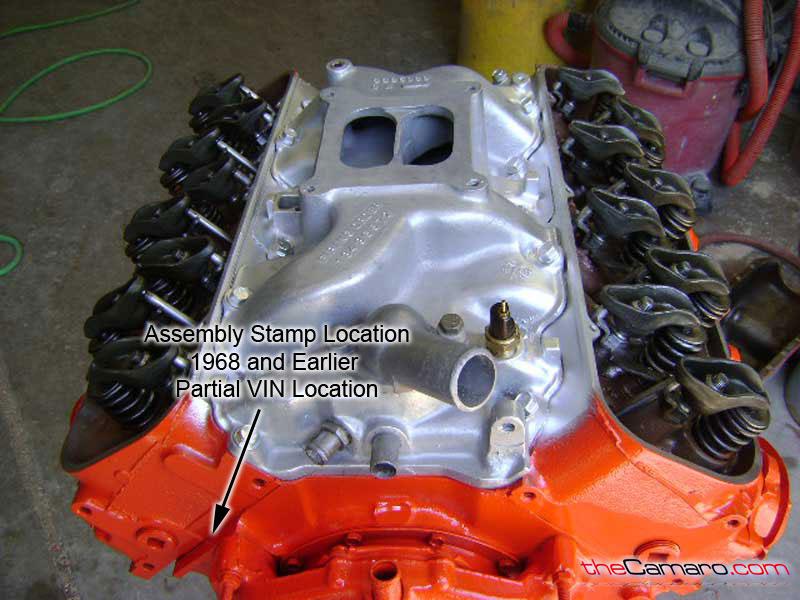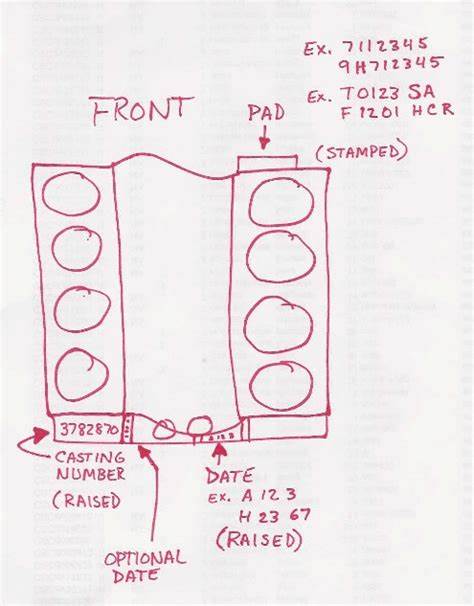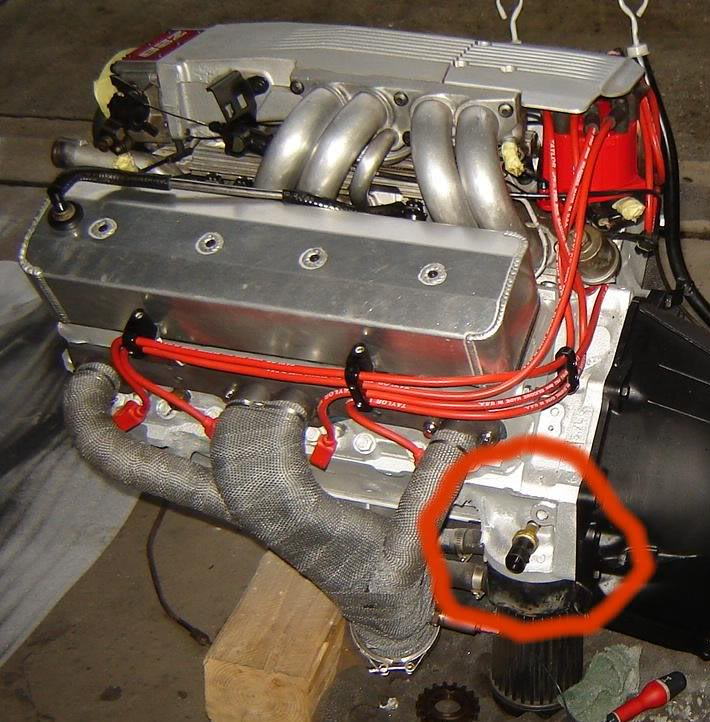So what are the odds that the tapped hole on the back of my 1990-ish small block Chevy for the oil pressure sender isn't 1/8" NPT x 27?
What else can it be?
FWIW, engine is installed. I have maybe 2" from the back of the block to the firewall. A 1/8" NPT nipple feels really close like it should thread in, but it doesn't.
Carp.
I don't remember what the original hole was but I had this problem on a 1993 caprice with an L05. I went from an idiot light to a gauge. The thread from the pressure switch was different than the analog. I ran a pipe tap into the hole and threaded the new sensor. It didn't leak. Sorry I don't remember what the original hole was.
NYN
In the 90s many of the engines started doing some random metric things.
Also, are you sure it's tapered? Some of the hydraulic fittings on later cars like the electronic transmissions' cooler lines were APT which is similar to NPT but not tapered.
Curtis73 (Forum Supporter) said:
In the 90s many of the engines started doing some random metric things.
Also, are you sure it's tapered? Some of the hydraulic fittings on later cars like the electronic transmissions' cooler lines were APT which is similar to NPT but not tapered.
I'm not sure of anything, including the year of the block. All I can do is feel a hole with my fingers. A 1/8 x27 NPT nipple will not start in it, so it's either a different thread, or the threads are munged up. I need to see if I can find a little mirror and try to get my eyeball on it.
Aren't GM blocks stamped with a number somewhere that will give me the year of manufacture?

They are usually stamped with ID numbers, but sometimes they don't help too much if they were a parts-counter block or a warranty replacement. GM continues to cast blocks for parts even after the production is done for warranty/parts purposes. Sometimes you can have (for instance) a re-cast of a 1986 block with a 1988 date code. In this case, you might have a date code that would suggest a one-piece rear main, but because it is a re-cast of a 1986 block, it actually has a 2-piece rear. Using the casting number AND the date code are the keys. Casting number can be found behind the driver's side head on the bellhousing flange (just in front of the transmission on the block). There is also sometimes a casting date on the opposite side behind the passenger head on the same bellhousing flange.
The code will be stamped on the flat pad just above the water pump in front of the head. The head deck surface continues past the front of the passenger side head and that's where it's stamped.
Decode here: https://nastyz28.com/sbchevy/sblock.html
Hmmm. Just got back in with the code and I see your post.
Code is
V1107PLB
Off to the decoding site. Be right back.
0 odds that's not 1/8 npt.
Well, shoot!
Flint, Michigan, made on November 7, but PLB I can find nowhere. Stamping was very clear. Guess I'll double-check it tomorrow, but I know I got it right.
Okay, this is getting weird. The Lime Book shows PLB is a 1988 230HP 454ci engine, manual trans TBI, from a truck. All of that agrees with my rough knowledge of this engine, with the notable exception of the cubic inches. I bought this engine as a fresh rebuilt 350. It's sitting in a '66 Chevy II. It ain't no big block.
Suffix codes are an odd thing. The most complete list of suffix codes I know of is at that NastyZ28 site I linked above, and more often than not they don't have the suffix code that I find. I think Chevy uses suffix codes to keep us all posting on forums in some marketing scam to keep advertising money flowing. Ok, not really, but they are a bit of a mystery. My guess is that the block started life as something other than a normal passenger car application; bus, marine, generator, warranty/parts, or sold to some aftermarket company that builds crate engines.
Let's start with the casting number and casting date. That will help us narrow it down anyway. I agree that it should be 1/8" NPT so it's probably just crusty or mangled. Unless your block was 96 or later, then it's possible it's metric.
In reply to Curtis73 (Forum Supporter) :
So, if I've interpreted what I've read correctly, there should be another code on the backside of the block?
I checked out the NastyZ28 site and couldn't find PLB, but this looks far more inclusive:
http://camaros.org/pdf/LimeBook.pdf
iansane said:
Patrick (Forum Supporter) said:
0 odds that's not 1/8 npt.
This.
Well, it appears we have a consensus!
I will proceed on the assumption that the threads are NPT and will need a bit of cleaning up.
Thanks to all!

1988RedT2 said:
In reply to Curtis73 (Forum Supporter) :
So, if I've interpreted what I've read correctly, there should be another code on the backside of the block?
I checked out the NastyZ28 site and couldn't find PLB, but this looks far more inclusive:
http://camaros.org/pdf/LimeBook.pdf
Three main things:
1) stamped code in front of passenger head tells you the plant, the month/day, and the application (or as we've found, sometimes the application)
2) casting date behind passenger head right where the bellhousing bolts up. This is usually a letter, two digits, then one digit. First letter is A-L for Jan-Dec. The two digits are the day, and the last digit is the year. On very rare occasions in the 60s, the initial character is a numeric representation of the month. So, for instance, J 25 8 would be Oct 25th 1968. The casting number will narrow down which decade in most cases.
3) casting code behind driver's head right where the bellhousing bolts up. This tells you the casting number which 99% of the time indicates what the block is, but not always. It's important to note that block molds are made by assembling cores. For the most part, a given casting number has specific pieces that fit together. For instance, the cylinder core piece from a 283 won't fit together with the crank case core for a 400. There are instances however where some pieces DO interchange. This is why you sometimes have a casting number that is described as "2 or 4 bolt main." The piece of the core with the casting number indicates that the majority of the block is the same among other like-cast blocks, but it is possible that two blocks with the same identical casting numbers are slightly different in ways that don't really matter. This caused confusion for decades about things like the rumored 010/020 blocks. For decades people believed that the 010 cast on the side meant that it was a high-nickel casting and therefore better. This has been debunked. The type of iron poured into the molds didn't change much over the years, and certainly not the high nickel content that people claim are in their blocks. The 010 or 020 were believed to indicate 1% nickel and 2% tin, but several GM foundry workers have finally put that myth to rest. The numbers cast into the side of the blocks were simply numbers identifying the core number. Take a look at this picture. These are SBC core parts

The 010/020 designations on the front and sides were simply parts of the core that didn't need to change, but it has nothing to do with the alloy used in the block. But if you do a search for it, good golly does it occupy a very large amount of bandwidth on forums. As you can see, they might cast a bunch of a certain blocks and be able to change out the crankcase core for 2 or 4 bolt without changing the core piece that carries the casting number. For this reason, the casting number isn't always the final word on what is actually inside.
Ah, shoot. I made an ID10T error.
Not being particularly familiar with the SBC, I was fumbling around in the wrong hole! Oooops. 
Why didn't somebody tell me it was on a horizontal surface? I was very much expecting it to be on a vertical surface. This is what comes of fumbling around in the dark.
After looking at some pictures and going back to the car, I find a plug half covered with sealant, directly adjacent to the intake. Aha!
Also, it seems these engines have another hole down by the oil filter. I'll need to put something in there also.
Curtis, Ima go sleuthing for more numbers in a day or two. I'm spread a little thin right now.
No other oil hole near the filter. Three pipe plugs go in the back of the block, above the crank, for galley access, but there's no other oil port to an uncovered part of the engine than your oil pressure gauge which is always 1/8NPT.
The 1/4NPT holes in the bottom of the block, right above the oil pan rail, are coolant drains. 
Stamp code here

casting number behind driver's side head on the bellhousing flange.


This thread was up on my screen, and my wife walked by and read the title. She replied "The odds that he's a dumbass? 100%!"
Hard to argue with that, so there is the answer to the question.
mtn (Forum Supporter) said:
This thread was up on my screen, and my wife walked by and read the title. She replied "The odds that he's a dumbass? 100%!"
Hard to argue with that, so there is the answer to the question.
She sounds like a hard woman. My condolences to you, sir! 
As far as the hole for the oil pressure sensor, it is on top of the engine at the back.... pretty much directly under the distributor just to the driver's side.

Later small blocks (TPI, LT1, and some TBI) had an additional 1/4" NPT near the oil filter on the side. Like this. They used a 1/8" NPT oil pressure switch in the normal location up top for the low pressure dummy light, and a 1/4" NPT sensor for a gauge down near the filter.

Okay.
Passenger side of rear of block: 14093638
Driver side of rear of block: GM 5.7 LG SGI
Front pad stamp: V1107PLB
This pic shows the threaded hole just above the oil filter,painted orange. Definitely larger than 1/8 NPT, maybe 3/8"?
I have found the proper port on the top of the block near the distributor and installed the oil pressure sender.
Yay!

14093638 Small Block V8 1987-1995 350, 2 bolt or 4 bolt, roller or flat tappet cam, 1-piece rear seal
Another thing to consider with older SBCs is how many ham fisted previous owners have done unspeakably sketchy things to the block before you ever even laid eyes on it.
Brett_Murphy (Ex-Patrón) said:
Another thing to consider with older SBCs is how many ham fisted previous owners have done unspeakably sketchy things to the block before you ever even laid eyes on it.
While that is surely true, I happen to know that this engine was built by an enthusiast who took the trouble to seek out this particular block to rebuild for his son's car. His son sold that car, and he was left with this engine.

That casting number corresponds to the few million TBI truck blocks out there. As you can see, interchangeable core pieces mean it can be cast as a 2 or 4 bolt main and a roller or flat cam.
That orange hole is most likely a 1/4" NPT, and likely not drilled beyond the threads. If you drill it out, you can use it as a pressure port. Probably easier to use a traditional 1/8" NPT sensor at the back of the intake below the distributor. If that hole is occupied, you can feel free to use a tee and add whatever you want. I do that sometimes. I will add a pressure switch there that grounds when it sees pressure. Then I connect a relay ground to it and I instantly have a third circuit that is only hot when the engine is running.
I did that with a solenoid on my old station wagon. I had a battery in the back for running a cooler, little TV, lights, etc when I camped in it. I could drain the coach battery since it was isolated from the starting battery. Then when the solenoid grounded, (engine running) it sent juice to recharge the rear battery. I also had a switch rigged up to ground. If the starter battery went dead, I could ground the solenoid with the switch and get a jump start from the rear battery.



























